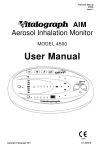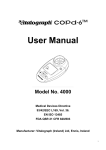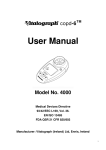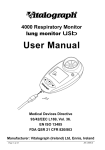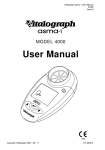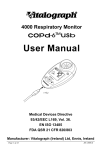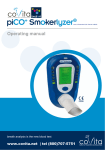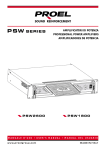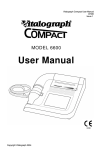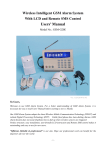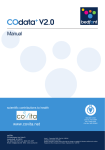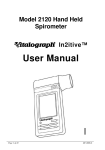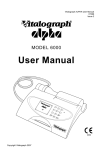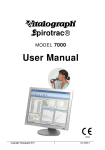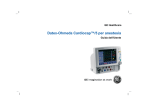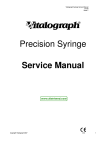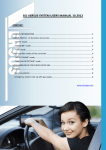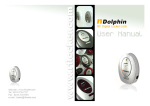Download Manual - coVita
Transcript
www.covita.net Table Of Contents Warnings and Advisory Notices 3 Main Components of The LungLife 4 What Is The LungLife Used For? 5 How To Use The LungLife 5 Entering Subject Data 5 Performing the Test 6 Reviewing the Last Session Test Results 7 Care and Cleaning Of The LungLife 8 Table of Materials Used and Cleaning/Disinfection Methods 8 Consumables, Accessories and Spare Parts 9 Explanation of Symbols 9 Technical Specifications 10 Warranty 10 Regulatory Notices for the LungLife11 CE Notice11 FDA Notice11 Declaration of Conformity12 Appendix13 Warnings and Advisory Notices Note: Please read all the information in this manual before using the LungLife. • This device is intended to measure lung function for use in clinics with disposable mouthpieces or filters or for patient use at home under medical supervision. • Take care not to block the mouthpiece with the tongue or teeth. A ‘spitting’ action or coughing will give false readings. • If used at home symptoms must take precedence over device measurements*. • If the device is used for longer than its specified life, the accuracy of the device may deteriorate. • Before use, ensure that the batteries do not exceed their shelf life, as indicated on the batteries. • Store in a clean dry place. * If you suspect that a defect has occurred you should check the LungLife for operation and accuracy. Main Components of the LungLife A Flowhead B On / off button C Display D User buttons A B D C What Is The LungLife Used For? The Lunglife is a device intended for measuring lung function. It can be used by a healthcare professional or assistant as a rapid pre-spirometry test to screen-out at-risk individuals that do not have COPD and indicate those that may be at risk of COPD at the pre-symptomatic stage of the disease. This “screening” or “case selection” for full spirometry examinations may result in earlier medical intervention and facilitate better clinical outcomes. How to use the LungLife Entering Subject Data The subject’s physical data can be entered into the LungLife in order to calculate predicted data. To enter the subject data, follow these steps: 1. Turn the device on, . 2. The age can now be set ( ). This is done by pressing the or button and releasing when the age is reached. The values will increase/decrease in values of 1. If the button is kept depressed, the values will scroll faster. Press the button to set the age. 3. The height can now be set ( ). This is done by pressing the or button and releasing when the height is reached. The values will increase/decrease in values of 1. If the button is kept depressed, the values will scroll faster. Press the button to set the height. Note: if height values are set below 100, the device assumes height is in inches. 4. The gender can now be set ( ). This is done by pressing the or button and releasing when the correct gender is showing (Male = ; Female = ). Press the button to set the gender. 5. The Population Group can now be set ( ). This is done by pressing the when the desired setting is reached. Press the or button and releasing button to set. N° . Population Group 1 European 2 Asian 3 African 4 Chinese 5 Japanese Performing the Test 1) The subject should sit down when blowing into the device (unless advised otherwise). Insert a new disposable one-way valve mouthpiece into the device. 2) When the device is ready for a test the blow icon shows ( ). 3) Instruct the subject and demonstrate (using a seperate mouthpiece) as follows: a) “Hold your head up, breathe in as deeply as possible, hold the device in front of your mouth”. b) “Hold your breath, place the mouthpiece into your mouth, like this, bite the mouthpiece lightly, and seal your lips firmly around it, like this”. I will demonstrate. c) “Blow out as HARD, and FAST as you can, like this, until I tell you to stop” (the unit will beep at end of test - after 6 seconds). d) “Be careful not to block the mouthpiece with your tongue or teeth. A ‘spitting’ action will give false readings”. e) “Now you do it – deep breath in – bite and seal – blast the air out…keep going – keep blowing”. f) “Well done! Now, we need to do that three times. Rest for a while until you are ready to blow again”. 4) To view the final result (the best values in the session), press the button. The Obstructive Index (OI) shows on the left hand arrow. i) Green is normal. ii) Yellow, amber or red are not normal and the patient should be referred for spirometry. 5) Following each blow and at the end of the test session, the FEV1 value will be displayed and below that, FEV1 % Predicted results for that blow, or for the best in session if the button has been pressed. Pressing again will toggle between best and last blow. 6) Press the button to show the estimated Lung Age ( ). Notes on testing: 1) During testing, if an exclamation mark (!) appears, this means that the last blow was not a good quality blow and the user should blow again. Reasons for poor quality are; a) Slow start of test b) Cough detected 2) If the test subject experiences side effects such as dizziness or fatigue during the test procedure, stop testing until recovered. Reviewing the Last Session Test The LungLife will always store the last test session, even after the device has powered itself down or has been switched OFF. In order to view the last test session, follow these steps; 1. Turn the device on, . 2. When the device is ready for age entry ( ), press the button for approximately 3 seconds. The last test session (best results) data will now show again. 3. When you have finished reviewing the data, press the OFF button for 3 seconds. OR 4. Press data. . The device will return to the age entry screen ready for entering the next test subject’s Care and Cleaning Of The LungLife A new mouthpiece should be used for each subject. A delay of at least 5 minutes should be allowed between subjects to allow settling of previously aerosolized particles in the measuring device. It is recommended that the device be regularly cleaned according to the guidelines of the user’s facility. The disinfection materials and procedures applied in the users’ facility may be more appropriate than the methods outlined below. In the event of visible contamination of the flowhead element, it should be cleaned or disinfected as described in the accompanying table. The device should be replaced in the event of damage, or if visibly contaminated. The frequency of cleaning and disinfecting is dependent on the facility’s risk assessment, usage, and test environment, but it should be at least monthly or every 100 subjects (300 blows). It is recommended that the device be replaced annually or test and calibration serviced at least annually. There is no planned preventive maintenance for this medical device. Table of Materials Used and Cleaning/Disinfection Methods This listing provides clinical users with information to allow the assessment of other suitable cleaning and disinfecting procedures available in their facility. Part Body Fascia Buttons Material PC/ABS Polycarbonate Synthetic Rubber Cleaning Recommendation Wipe with a damp cloth Wipe with a damp cloth Wipe with a damp cloth Disinfection Recommendation Alcohol wipe (IPA 70-90%) Alcohol wipe (IPA 70-90%) Alcohol wipe (IPA 70-90%) All external parts of the LungLife require cleaning, i.e. the removal of visible particulate contamination. Do not attempt to insert any object or to clean the rotor or stator in the measuring system. This device is not designated as a ‘sterile’ device. Wiping with a 70% Isopropyl Alcohol impregnated cloth provides a suitable form of cleaning and low-level disinfection for the case exterior. Repeat this at least weekly to prevent a build-up of grime from normal handling and use. Always follow the safety guidelines given by the manufacturer of cleaning and disinfectant chemicals or equipment. Definitions of cleaning and disinfection are as defined in “Sterilization, Disinfection and Cleaning of Medical Equipment: Guidance on Decontamination from the Microbiology Committee to Department of Health Medical Devices Directorate, 1996” Recommendations for chemical disinfectants are derived from the PHLS publication “Chemical Disinfection in Hospitals” 1993. Consumables, Accessories and Spare Parts SPIRMP One-way valve spirometry mouthpieces (200) Explanation of Symbols Device symbols; Type BF equipment Class II The device must be taken to separate collection at the product end-of-life. Do not dispose of these products as unsorted municipal waste. ! Attention (reference relevant section in manual) User Interface Symbols; Battery status: Full Battery status: Half Battery status: Empty (flashing) Blow Now Symbol ! Bad Test Symbol (slow start or cough) Lung Age Symbol Age Symbol Height Symbol Gender Symbol Population Group Symbol Technical Specifications Material: PC/ABS Accuracy: Better than ± 3% Flow Impedance: Better than 0.15kPa/L/s at 14L/s Measurement Range: 0 – 9.99 L BTPS Performance And Safety Standards: ATS/ERS Guidelines 2005 Electromagnetic emissions: CISPR 11 Group 1 (battery operated) Electromagnetic immunity: IEC 61000-4-2, IEC 61000-4-3 (battery operated) Sensor: Stator/rotor Power Supply:2 x AAA batteries Operating Temperature:17 – 37°C ! Bad Test Criteria: Slow start of test (Vext>5%) or a cough detected in the first second Auto power down time: Set to 2 minutes as standard Warranty Your Vitalograph copd-6/ Bedfont LungLife is guaranteed for one year*. Replace if it is faulty, otherwise replace the unit every three years. * Excepting accidental / transit damage or inappropriate use of the device. Vitalograph Ltd. Maids Moreton Buckingham MK18 1SW England Tel: +44 (0) 1280 827110 Fax: +44 (0) 1280 823302 Email: [email protected] www.vitalograph.co.uk Vitalograph Inc. 13310 West 99th Street Lenexa Kansas 66215 USA Tel.: (913) 888 4221 Fax: (913) 888 4259 Email: [email protected] www.vitalograph.com Vitalograph GmbH. Jacobsenweg 12 22525 Hamburg Germany Tel: (040) 547391-0 Fax: (040) 547391-40 Email: [email protected] www.vitalograph.de Vitalograph (Ireland) Ltd. Gort Road Business Park Ennis Co.Clare Ireland Tel.: (065) 6864100 Fax: (065) 6829289 Email: [email protected] www.vitalograph.ie 10 Regulatory Notices for the LungLife CE Notice Marking by the symbol indicates compliance of the this devise to the Medical Devices Directive of the European Community. Such marking is indicative that the Vitalograph copd-6/Bedfont LungLife meets or exceeds the referenced technical standards. The device uses RF energy only for its internal function. Therefore, its RF emissions are very low and are not likely to cause any interference in nearby electronic equipment. The device is battery operated and is suitable for use in all establishments, including domestic establishments and those directly connected to the public low-voltage power supply network that supplies buildings used for domestic purposes. The device is intended for use in the electromagnetic environment specified below. The customer or the user of the system should assure that it is used in such an environment. • Floors should be wood, concrete or ceramic tile. If floors are covered with synthetic material, the relative humidity should be at least 30%. • Power frequency magnetic fields should be at levels characteristic of a typical location in a typical commercial or hospital environment. • Interference may occur in the vicinity of equipment marked with the following symbol - . FDA Notice Caution: Federal Law restricts this device to sale by, or on the order of a physician. 11 Declaration of Conformity Product: Vitalograph copd-6/Bedfont LungLife Vitalograph hereby ensures and declares that the above product associated with this user manual, is designed and manufactured in accordance with the following QMS regulations and standards: European Medical Devices Directive {MDD} 93/42/EEC. This device, classified as 2a as per Annex IX of MDD 93/42/EEC, meets the following provisions of Annex II of the Medical Devices Directive as per Article 11, section 3a, excluding point 4 of Annex II. This device complies with the EMC Directive 89/336/EC, conformance demonstrated by following standard EN60601-1-2:2001. Equipment classification: Residential. Canadian Medical Device Regulation {CMDR} FDA Quality System Regulation {QSR} 21 CFR 820. EN ISO 13485: 2003. Medical devices. Quality management systems. Requirements for regulatory purposes. Certifying Body {for 93/42/EEC and CMDR}: British Standards Institute {BSI} Certificate Nos. CE 00772, MD 82 182, FM 83550 12 Appendix Recommended separation distances between portable and mobile RF communication equipment and the system The device is intended for use in an electromagnetic environment in which radiated RF disturbances are controlled. The customer or the user of the system can help prevent electromagnetic interference by maintaining a minimum distance between portable and mobile RF communications equipment (transmitters) and the system as recommended below, according to the maximum output power of the communications equipment. Rated maximum output power of transmitter (W) Separation distance according to frequency of transmitter (m) 150 kHz to 80 MHz d = 1.2 P 80 MHz to 800 MHz d = 1.2 √P 800 MHz to 2.5GHz d = 2.3 P 0.01 0.1m 0.1m 0.2m 0.1 0.4m 0.4m 0.7m 1 1.2m 1.2m 2.3m 10 3.7m 3.7m 7.4m 100 11.7m 11.7m 23.3m For transmitters rated at a maximum output power not listed above, the recommended separation distance d in metres (m) can be estimated using the equation applicable to the frequency of the transmitter, where P is the maximum output power rating of the transmitter in watts (w) according to the transmitter manufacturer. Note 1: at 80 MHz and 800 MHz, the separation distance for the higher frequency range applies. Note 2: these guidelines may not apply in all situations. Electromagnetic propagation is affected by absorption and reflection from structures, objects and people. 13 U.S. Customers, please contact: coVita tel: 800-707-5751 fax: 800-721-2377 email: [email protected] www.covita.net Bedfont Scientific Ltd Bedfont Scientific Limited reserve the right to change or update this literature without prior notice. Registered office: England and Wales. Registered No: 1289798 ISO 9001:2000 Cert No. FM 31664 ISO 13485:2003 Cert No. MD 502905














